Hello! Ever experienced the joy of classic red sauce? It’s the ultimate comfort food – simple, yet oh-so delicious. Remember the red sauce from our childhoods? Well, this version is a game-changer—it’s entirely meat-free, thanks to TVP. So, you get all the flavor without the beef. Let’s create some tasty, meatless memories!
Fantastic news for our veggie and vegan friends! This twist on the classic red sauce, powered by textured vegetable protein, is a delightfully inclusive choice for everyone. And here’s the real magic – nobody will be sacrificing any flavor!

Usually, I go for Bob’s Red Mill TVP – it’s my go-to! It’s a breeze to find on my travels, and the quality is top-notch. For the best deals, I check out the bulk sections at health food stores. But, hey, we all end up in spots where TVP is MIA. In those moments, Amazon swoops in to save the day – my trusty go-to for all things TVP!

Check out this textured vegetable protein goodness (pictured above) – it’s crafted from defatted soy, making it a shelf superhero! Perfect for those times when zombies are on the prowl or a hurricane plays hide and seek with your power. And let’s talk recipes – ever tried to dodge mystery meat? Some animal bits pack more purine punch than others. Take rib loin with 74.2 mg per 100 g compared to the heart’s 185 mg per 100 g. Hearts are lean and beefy but often underappreciated, ending up in the grinder. Unlike rib loin or rib eyes, they escape the grinder’s fate. That’s why I steer clear of prepackaged ground beef, even the leaner blends. Enter textured vegetable protein – my flavor-packed savior!
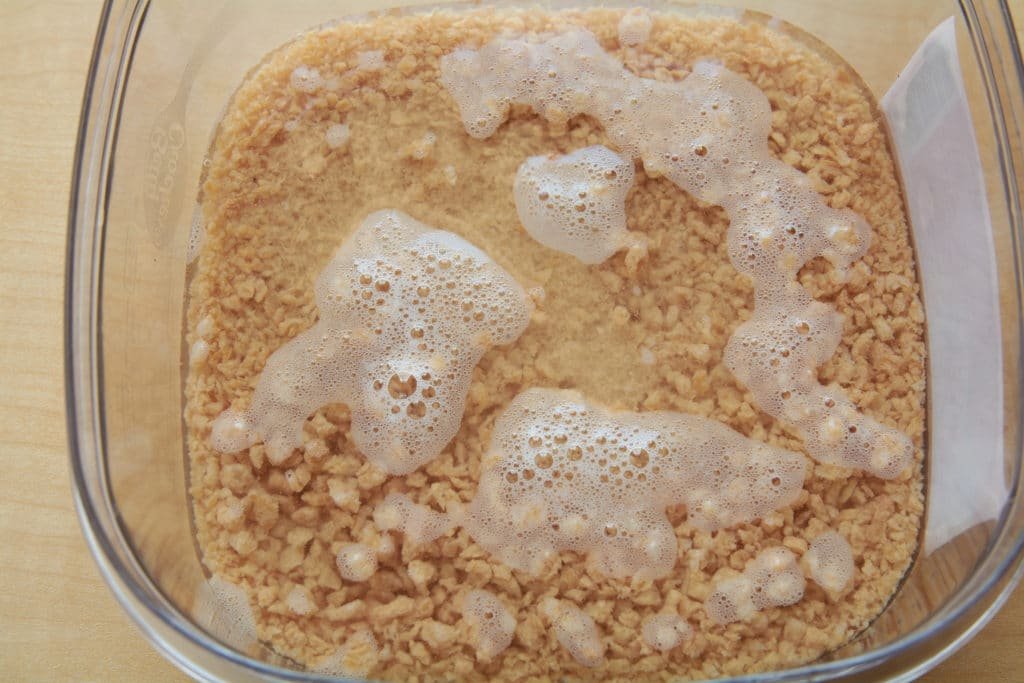
Now, let’s dive into the exciting world of preparing textured vegetable protein! It’s a breeze, promise. With its lengthy shelf life, feel free to stock up in your cabinet – ready for action whenever you need it (zombie invasion, anyone?).
Rehydrating this superhero food is a piece of cake. For every cup of TVP, just add two cups of water, hot or cold – your call! Hot water means a quick five-minute soak, while cold water takes a leisurely twenty minutes. I’m team cold water; that gives me the perfect window to prep my veggies and more. Once soaked, give it a little squeeze to bid farewell to excess moisture, reducing that raw soybean taste and making it a breeze to fry up. Let the textured goodness begin!

Behold the transformation after a good soak and a gentle squeeze to bid farewell to excess moisture. I get it; right now, it’s not winning any beauty contests, but fear not – we’re about to turn this humble beginning into something truly appetizing!
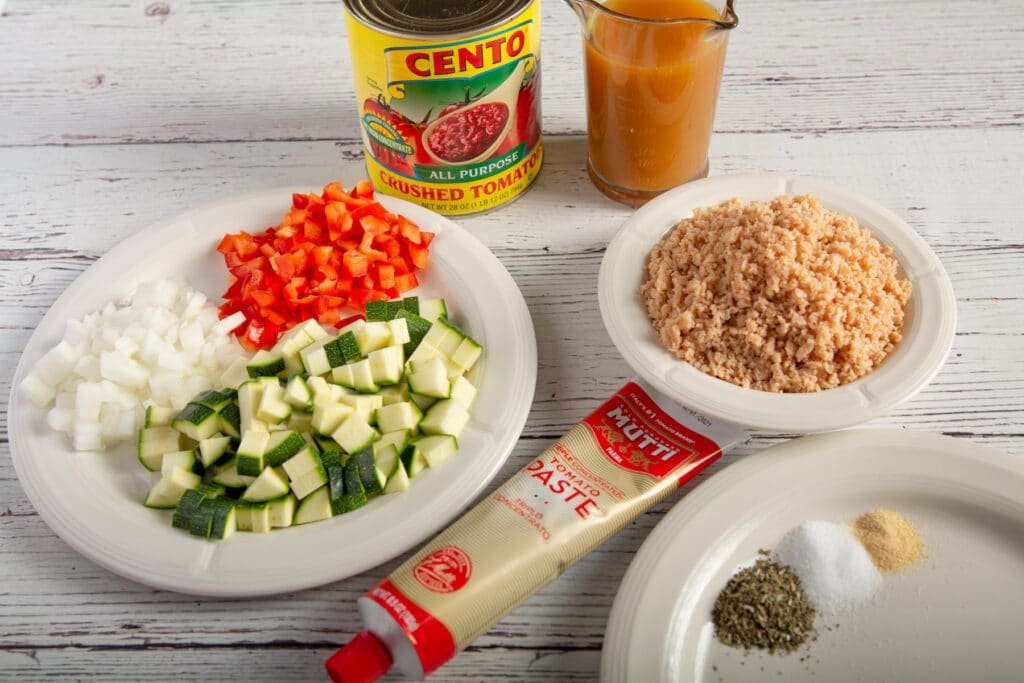
Get ready for a pasta sauce that’s practically a veggie wonderland! Now, let’s chat about TVP – it’s a bit on the bland side, not packing a ton of texture. No worries, though – we’ve got a veggie party going on to compensate! Since TVP is more of a flavor sponge than a flavor powerhouse, remember that when fine-tuning the recipe to your taste buds’ delight. Let’s make it your own flavorful masterpiece!
We threw in some zucchini, sweet red bell pepper (way sweeter than the green ones), onion, and garlic for this round. Feel free to tweak the recipe depending on the veggies you love or what’s in season. No matter how you slice it, you’re turning this sauce into a vitamin-packed powerhouse!
Red Sauce Ingredients:
Including zucchini increases the vegetable content of the sauce, providing a diverse range of nutrients. This is a great way to boost the nutritional profile of the dish and add more variety to your diet.
Red bell peppers are rich in vitamins, particularly vitamin C, and other antioxidants. Adding them to the sauce not only enhances nutritional value but also contributes to the overall health benefits of the dish.
Garlic: The aroma of garlic, especially when sautéed, creates an inviting and appetizing atmosphere in the kitchen. The pleasant fragrance intensifies the sensory experience of the dish.
Carrots bring a natural sweetness to the sauce, helping to balance the acidity of tomatoes. This sweetness can enhance the overall taste and reduce the need for added sugars.
Mushrooms contribute a rich and savory umami flavor to the sauce. This enhances the overall taste profile, adding depth and complexity to the dish.
Celery is a low-calorie vegetable that adds a nutritional boost to the sauce. It contains essential vitamins, minerals, and antioxidants, contributing to the overall health benefits of the dish.
Salt is a natural flavor enhancer. When used in moderation, it can amplify and bring out the natural flavors of the other ingredients in the sauce, including tomatoes and herbs.
Oil acts as a carrier for fat-soluble flavors, enhancing the overall taste of the sauce. It helps distribute and intensify the flavors of herbs, spices, and other ingredients.
Italian seasoning typically includes a blend of herbs like oregano, basil, thyme, and rosemary. These herbs work together to create a harmonious flavor profile that complements the tomatoes in the red sauce, enhancing the overall taste.
Canned tomatoes provide a consistent flavor and texture throughout the year. This is especially beneficial when fresh, ripe tomatoes are not in season, ensuring that you can maintain a reliable taste regardless of the time of year.
Vegetable stock adds depth and complexity to the flavor of the red sauce. The combination of various vegetables, herbs, and spices in the stock contributes a rich and savory taste.
Tomato paste acts as a natural thickening agent, contributing to a richer and heartier sauce. It helps achieve the desired consistency without excessive cooking time.
Garlic powder disperses more evenly in liquid than fresh garlic, contributing to a more balanced distribution of garlic flavor throughout the sauce. This can be particularly advantageous in achieving a consistent taste.
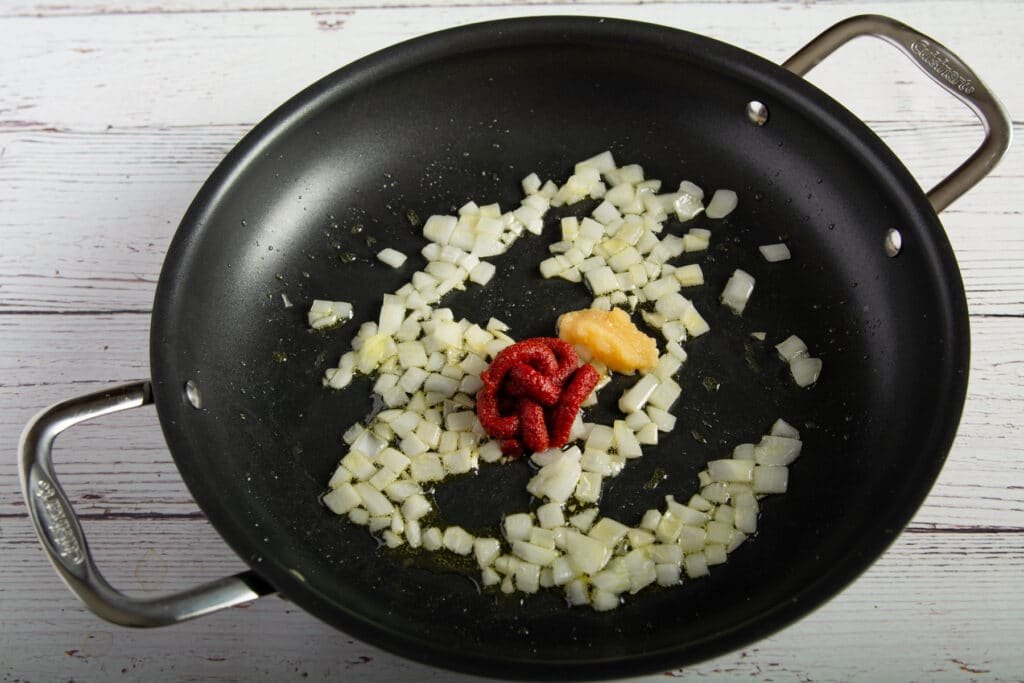
Here’s a tasty tip for a flavor boost: fry up your tomato paste! It’s a simple move but makes a big impact. This little trick helps caramelize the sugar in the paste, giving your sauce a delightful sweetness and balancing out the tomato acidity – all without needing to add extra sugar.
To kick off our Red Sauce adventure, start by adding a splash of olive oil to a pan over medium heat. Once it’s sizzling, toss in your diced onion with a pinch of salt (that teaspoon we talked about). Let it sizzle for about two minutes to get those onions nice and soft. Then, in goes the tomato paste and garlic – let the flavor fiesta begin!

Keep that stirring game strong and let the magic happen over medium heat for roughly 10 minutes. Watch for the onions to hit that sweet spot of softness, and notice how the tomato paste takes on a subtle, inviting darkness. Sure, you could crank up the heat and speed up the process, but trust me, the low and slow-approach is where the real magic unfolds. Your patience is about to be rewarded with some seriously flavorful results!
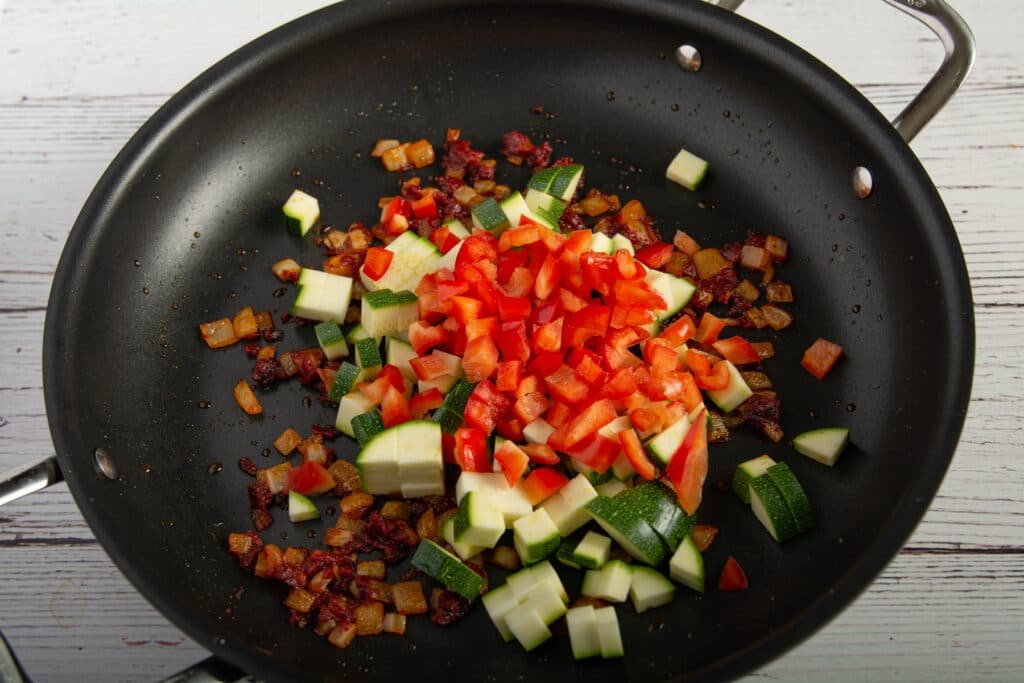
Once that tomato paste has worked its color-changing magic, it’s time to invite the rest of the veggie crew to the party. Sprinkle in another pinch of salt, and let the flavor fusion continue!

Keep that stirring rhythm going strong as you let the veggies dance in the pan for about 5 minutes. The goal? Get them to start sharing some of their water, creating a flavorful symphony. But here’s the key: no burning allowed! We’re aiming for a harmonious blend, not a charred catastrophe. Keep the heat in check, and let the veggies serenade the sauce with their delicious moisture.
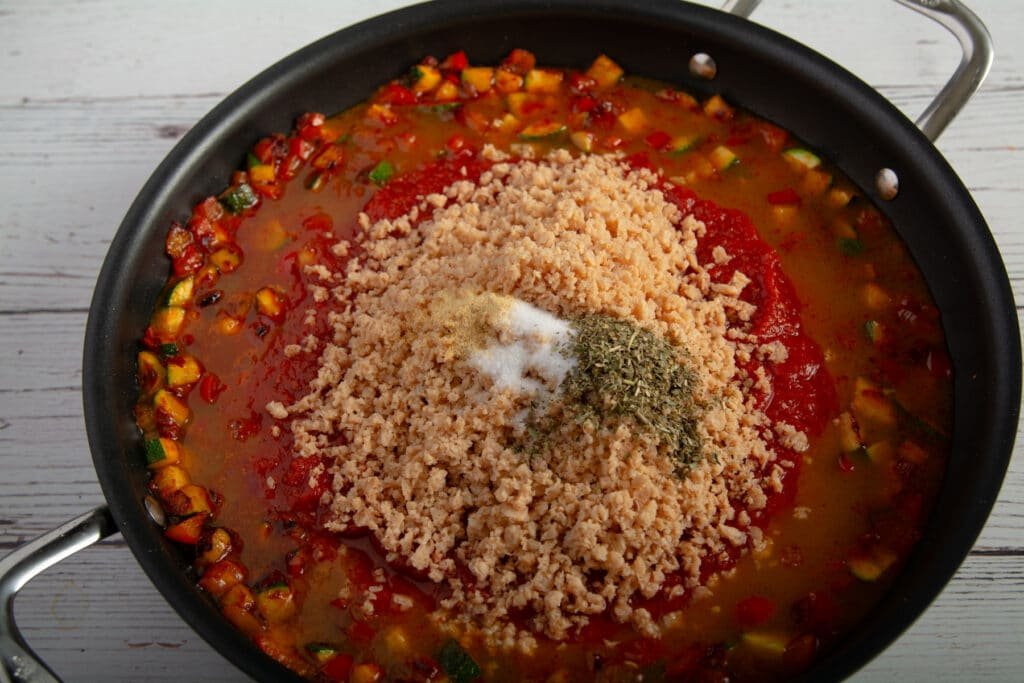
Don’t let that tomato paste misbehave! If it’s getting too cozy with the flames or your veggies are striking a perfect pose, it’s time to bring in the reinforcements. Add in the canned tomatoes, the rejuvenated TVP, the veggie stock, and the seasoning squad (salt, Italian seasoning, and a sprinkle of garlic powder). Here’s a pro tip: hold off on dumping all the remaining salt at once. Start with about half, taste as you go, and save the rest for the grand finale.
Now, here’s where your personal taste takes center stage. Depending on your flavor preferences and the dynamics of your veggie stock and canned tomatoes, you might need to fine-tune that salt situation. So, toss in about half now, and when the sauce is nearing perfection, do a final taste check and adjust. Remember, you can always add more, but once it’s in, there’s no turning back. Let the saucy symphony continue!

Let the simmering symphony continue! Keep an occasional eye on that sauce as it works its magic over medium to low heat for about fifteen minutes. As it reduces, beware of the saucy rebellion – it might bubble and attempt to redecorate your kitchen. Fear not! Slow and steady stirring, and a gentle reduction in heat, are your secret weapons.
Give your sauce a taste test and fine-tune the flavor. Feel like it needs an extra pinch of salt, a dash more garlic, or any other seasoning flair? Now’s the time to sprinkle in the magic and let it simmer on low for an additional five minutes. Your sauce has officially reached masterpiece status!
For a final touch of freshness, imagine a flurry of fresh basil dancing onto your plate just before serving. Chop or shred it right on top of the saucy masterpiece – it stays green and fabulous. Remember, no one wants black basil at the feast!
Now, cook up your favorite pasta and generously ladle on that flavorful sauce. While fresh basil would be a dream, sometimes the store has other plans (like only selling it in bulk for a small fortune). No worries – your plate will still be delicious.
But what about the leftovers? Fear not, kitchen maestro! Portion that extra goodness into individual containers and into the freezer it goes. Voila! Quick, delightful meals whenever the craving strikes.
Just a quick heads up – your leftover TVP pasta sauce will happily chill in the fridge for four or five days. For the long haul, stash it in the freezer, and it’ll keep the flavor party alive for up to three months. Bon appétit!
Hey there! I shared the video above on YouTube, applying some of the cool techniques from this recipe. The meatballs in the video were crafted with ground beef, but guess what? I’ve got something exciting in the works – a version with black beans! Stay tuned for that tasty twist!
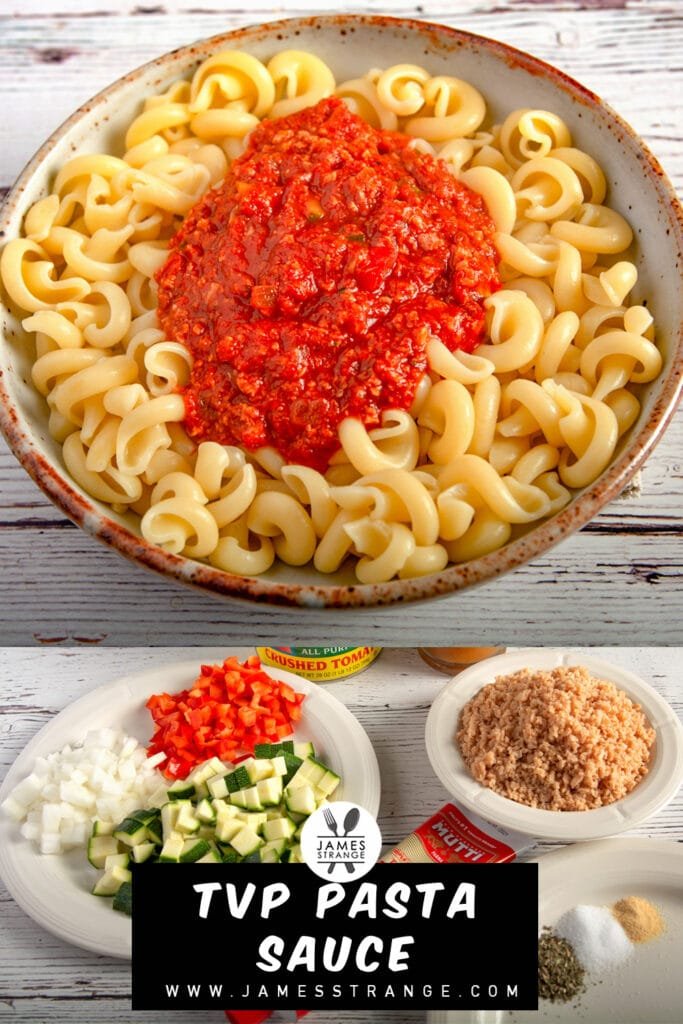
If you enjoyed whipping up this delightful sauce, why not spread the love? Share the recipe with your fellow food enthusiasts and let the saucy goodness be a part of more kitchens! Happy cooking and sharing!
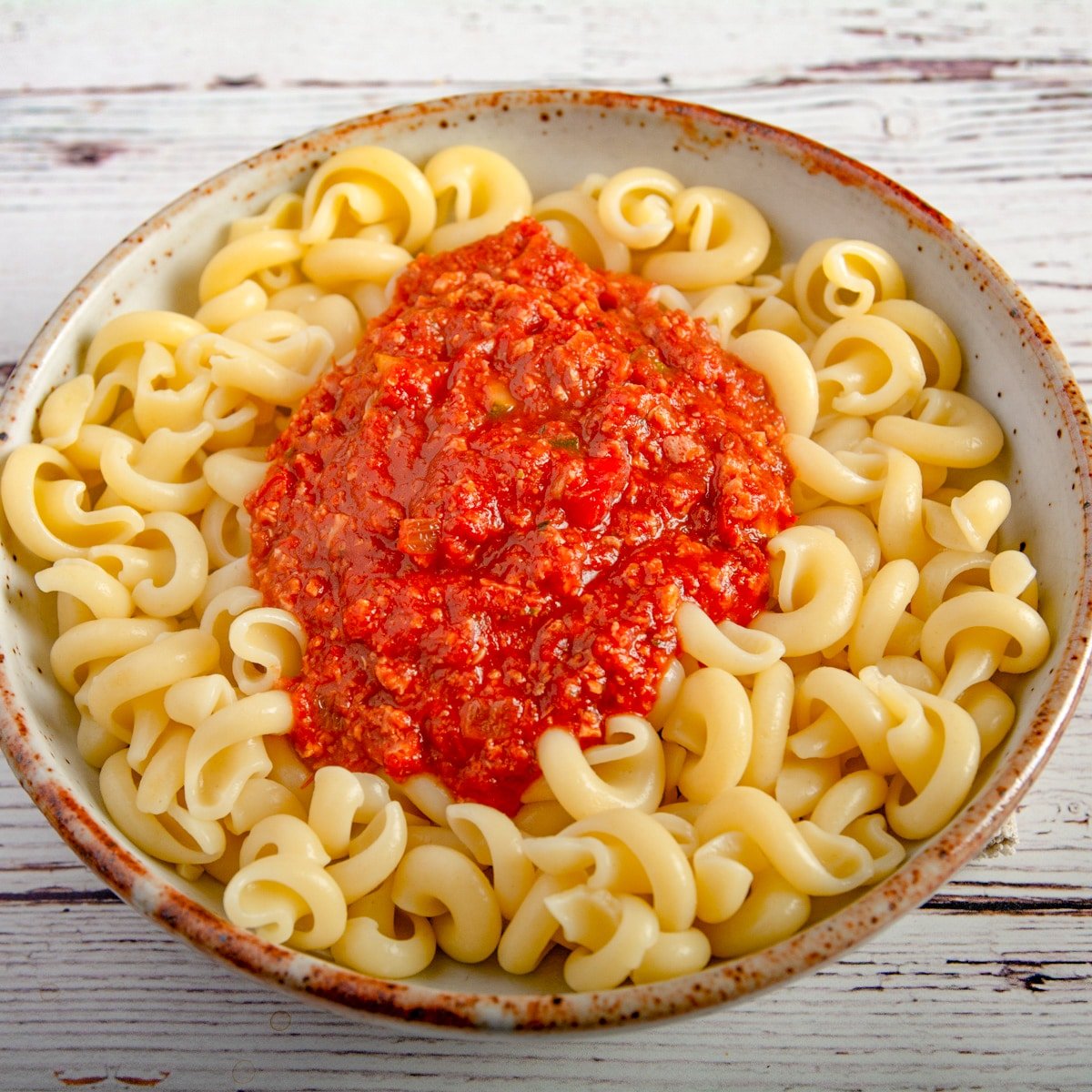
Ingredients
TVP
- 1 Cup textured vegetable protein
- 2 Cups Water
Veggies
- 1 Tablespoon Olive Oil extra virgin
- 2 cloves Garlic minced
- 1/2 Cup Onion diced
- 2 Tablespoons Tomato Paste
- 1/2 Cup Bell Pepper diced
- 1 Cup Zucchini diced
Seasoning
- 1 teaspoon salt
- 1 teaspoon Italian Seasoning
- 1/4 teaspoon garlic powder
Other
- 28 oz tomatoes 1 28 oz can tomatoes
- 1 Cup Veggie Stock
Instructions
Hydrate the TVP
- To one cup of textured vegetable protein add two cups of water.

- Let soak twenty minutes
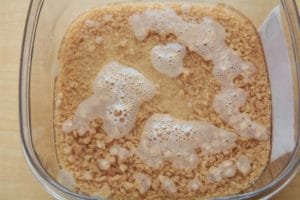
- Squeeze out excess water and set aside.

Cook the veggies
- To a pan on medium heat add one tablespoon of olive oil. Add the onion and cook until the onion has softened (about two minutes). Add the fresh garlic, tomato paste and a small pinch of salt. While stirring often cook on medium heat for about 10 minutes or until the tomato paste has slightly darkened.

- After the tomato paste has changed color add the rest of your veggies. Add another pinch of salt. While continuing to stir cook your veggies for about 5 minutes or so.

Finish the sauce
- After the veggies have cooked add the can of tomatoes, rehydrated TVP, veggie stock and seasoning. While occasionally stirring cook on medium to low heat for about fifteen minutes.
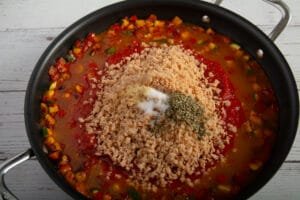
- Check and adjust seasoning. Cook for an additional five minutes.
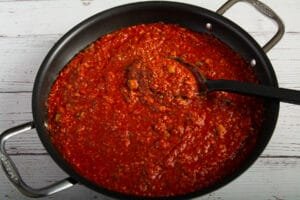
- Now the sauce is ready to serve.

[…] image source […]
[…] 19. Tomato Zucchini Pasta Sauce […]